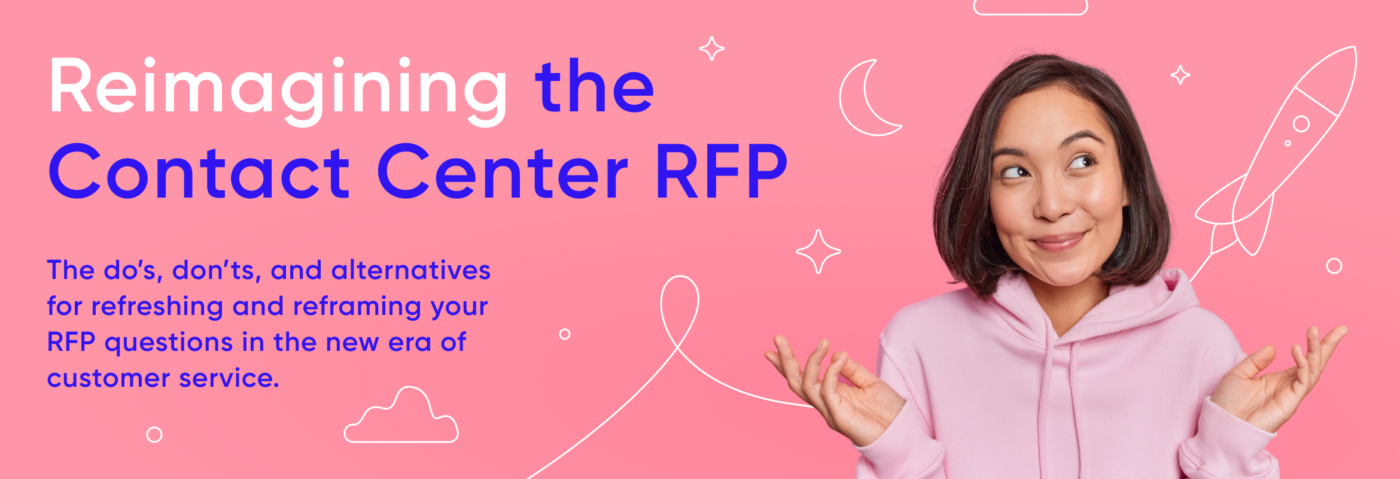
Reimagining the Contact Center RFP
The do’s, don’ts, and alternatives for refreshing and reframing your RFP questions in the new era of customer service.
It’s time to breathe new life into your RFP
Are you asking the right questions to ensure you get the best business results possible from your CX partner?
As the demands of today’s consumers evolve, so too does the state of CX. In order to truly optimize CX quality and efficiency, businesses must be ready to adapt, and this includes the questions they ask in a contact center RFP.
Rather than settling for “good enough” customer service, companies should be looking for solutions that generate revenue through increased customer engagement and ultimately drive CX transformation. Asking the right questions is critical to ensuring that businesses are prepared for the future of CX, where, within the next decade, Simplr predicts 90% of customer service inquiries will be automated or proactively prevented.
While RFPs are a formal way of evaluating potential partners, the traditional approach has not kept pace with the digital demands of CX. The questions are often based on an outdated model focused on cost savings rather than revenue generation. To find a CX partner that can meet the demands of today’s consumers, businesses must ask questions that focus on flexibility, cutting costs while increasing revenue, and awareness of the changing CX landscape.
In this guide, we’ll explore why the traditional outsourced customer service RFP is out of touch and provide insight into the questions that businesses should be asking to ensure they achieve their goals of optimizing CX quality and efficiency, generating revenue with customer engagement, and driving CX transformation.
Outdated RFP questions that won’t get results
Before we dive into questions that will work, let’s revisit the ones that are getting stale.
While it may be a formality for your business, the RFP process is often long and arduous, and—dare we say it—a waste of time if you are asking the wrong questions.
The following are just a few examples of the impersonal questions that fail to give customer service outsourcing vendors a real opportunity to get creative and provide a full 360-degree view of their offering(s):
- Where are your HQs located? Please share locations of all your offices.
- Does it matter where their HQs are located? Or even their contact centers? Given the prevalence of gig workers, how much does this matter?
- Name your five largest clients.
- Largest? How about focusing on longest tenured See if they’ve been able to scale support with growing brands and maintain relationships.
- What is it that you do best and differentiates you from other agencies?
- This one’s begging for a boilerplate answer. Instead, ask them what innovations they’ve made in the last year? This could be valuable given the ever-changing and digital evolution in the CX space.
Click here to see which other RFP questions are getting a little stale!
New questions you must ask in your next contact center RFP
And now, on to the good stuff! Here are a few questions that are heavily focused on everything today’s customer seeks from your brand, plus the results you’d like the company to see such as higher quality and efficiency, more flexibility, best-in-class response times and more revenue opportunities:
- What does your hiring / talent sourcing process look like? Do you offer specialized skills beyond basic CS (back office, product knowledge, etc.)?
- Why it matters: You want a partner that hires for skills that can scale. The best agents are ones that can handle a variety of situations, adapt on the fly and always lead with empathy.
- What capabilities do you have to route customers to the best agent based on their lifetime value or purchase history?
- Why it matters: It’s incredibly frustrating to get routed to a chatbot or agent that can’t solve your issue. Your BPO provider should have capabilities that ensure each customer is getting routed to the best possible agent to resolve their inquiry if you want the highest CSAT scores.
- Tell me about one of your most successful partnerships. What was the previous state of their customer service experience and what does it look like today?
- Why it matters: Are they able to scale support with growing brands and maintain relationships? This question will certainly help you find out!
If a traditional call center is not equipped to meet those expectations for CX, these additional questions will surely make them squirm!
A new RFP for the NOW Customer
Finding a CX partner that will help you transform your CX organization is key. But the ability to find a like-minded partner hinges on the ability to ask incisive questions that serve the best interest of your business and the NOW Customer. Reach out to our team today to learn how we keep our walls up so you can keep your business running.